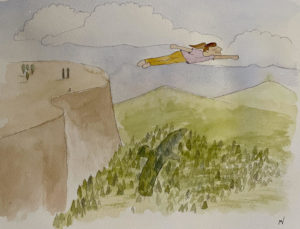
Working Paper
How Recife responded to the challenge of learning deficit...
May 12th 2025
School closures during COVID-19 caused learning losses worldwide, often compoundin...
Read MoreA woman stood on the side of a cliff, looking nervously at a vast and dense forest. She felt small, foreign, like this was too much to handle. Suddenly, she noticed an eagle passing over her head, navigating over the enormous trees. The eagle found its prey and carried it through the forest with elegance and focus. At one point, it turned back, flying towards the woman who heard the bird whisper, “What if she remembers she also has wings?”
“What if she remembers she has wings?” This question surfaced in one of the first Feminine Leadership Coaching Circles we held this year in partnership with Lever for Change and the Eileen Fisher Leadership Institute. The circles gather women leaders from the Bold Solutions Network [1] working on a wide range of development projects across the globe to work together and explore challenges, aspirations, and places for growth in their lives and work.
Coaching circles provide a place for participants to listen to and support each other, free of judgement, cynicism, or fear. They are a place of respite. The circles are an opportunity for women to reconnect with their potential, tap into the collective knowledge of other female leaders, explore and reflect on their personal leadership journey, and develop a lasting peer network of support. They are a space for women to find a way to spread their wings and lead. For two years, IMAGO has been facilitating these virtual coaching spaces with the aim of helping women own their leadership skills as they lead organizations and teams.

⚬ ⚬ ⚬
Coaching Circles involve a group of participants (in this instance, 4-5 women in similar positions of responsibility, relatively unknown to each other) that come together to reflect on their challenges, aspirations, and dilemmas at the workplace in an hour-long meeting. Specifically, the circles explore what feminine leadership means to each of the women and how to embrace its unique characteristics. The circle is designed to be an immersive experience that encourages participants to “listen” rather than “react.” Coaching Circles are built on trust and camaraderie among peers and attempt to foster a holding environment, a safe place to share one’s thoughts and feelings.
A typical coaching circle has two main roles — Inquirer and Coach. The Inquirer shares a personal aspiration, leadership challenge, or current impasse in which she is a key player, with the goal of gaining more valuable insight on how to move forward. The remaining participants in the circle become Coaches. Their role is to listen to the Inquirer while also attending to images, metaphors, feelings, and gestures that the Inquirer’s story evokes in each of them. In a typical circle, a different participant volunteers to be Inquirer each time. In this way all participants act as Inquirers and Coaches to each other.
The meeting begins with the Inquirer sharing her story in an intention statement, aided by guiding questions that push her to describe what she is dealing with, how others might see it, what she needs to let go of, what she needs to learn, and where she might need input or help. While the Inquirer shares, other participants are invited to actively listen.
After the Inquirer presents her case, all participants take a Moment of Stillness, a time of silence where everyone closes their eyes and thinks about what resonates from the story that was shared. This is followed by Mirroring, in which Coaches reflect back to Inquirer in their own words what they heard, sharing any allegory, impressions, or visual snapshots that came to their mind during the silence. The Inquirer listens patiently to each Coaches’ interpretation of their story, and then once every Coach has mirrored, she shares her reflections. After this begins Generative Dialogue, a space where all participants reflect on how these observations can offer new perspectives on the Inquirer’s situation and journey. The objective is to build on each other’s ideas and to stay in service of the inquirer without pressure to fix or resolve their challenge.
Finally, there is space for closing remarks by all participants. The inquirer may reflect on the question “How do I now see my situation and way forward?”. This is also a time to express a genuine appreciation to each other. If time allows, participants may spend some time journaling to capture the learning points before returning to plenary for closing.
⚬ ⚬ ⚬
The experience of being in the room while these intimate conversations between women are happening, witnessing deep listening and genuine interaction, is magical! We are all so busy all the time that it is heartening to see this take place. The usual feeling women share as they leave the circle is: “we are in this together.” Realizing that many women in similar positions from different organizations experience the same challenges is very comforting for participants. Furthermore, there is a sense of joy and fulfillment at the end of the circles. The gift of time to be present is very much appreciated.
Over the last two years of running these coaching circles, many common themes have emerged. Women have been incredibly open about the difficulties of balancing work and family responsibilities, especially as the world transitioned to home-office. They have shared the challenges of managing people with different capacities and leadership styles as well as the need for nurturing women and themselves to own their feminine leadership traits, including the need to speak up and take a seat at the table in male dominated spaces. Among many other topics women participants often show concern and an urgency for topics usually overlooked, but extremely important, such as diversity, equity, and inclusion.
This kind of peer coaching circles has become a common practice for leadership development. The idea of bringing together peers from different teams with similar work experiences has gained momentum and is increasingly seen as a way of personal and professional development (Steinber & Watkins, 2021). At IMAGO, we follow the Case Clinic methodology developed by the Presencing Institute. Nonetheless, there are many ways to run peer coaching circles. Some of the common elements include: an inquiry process that synchronizes multiple contributions, participants from diverse backgrounds, role-playing, and everyone serving as a coach.
The key to run a good coaching circle is the structure, but also ensuring it that it self-sustainable and continues beyond IMAGO’s involvement. Because it takes a while for participants to get used to the format, having someone in the circle who is familiar with it to serve as facilitator helps a lot. But as soon as participants become familiar with the structure and format, empowering them to take ownership becomes more relevant to foster continuity of the space in time. In 2021, we invited our women participants from circles in 2020 to take the role of lead coaches and guide the circles. Empowering women to run their own coaching circles is important to scale the idea and ensure more women can create safe spaces to be supported and heard.
⚬ ⚬ ⚬
My experience of hosting coaching circles for IMAGO has been transformative and uplifting. I have witnessed firsthand how women care deeply about their roles and relationships with others in their organizations, and how they are so generous with their time, often sacrificing selfcare to prioritize their family and their work. These women give me confidence and serve as an inspiration. Finally, the circles taught me the value of having a safe space. To me, Coaching Circles, at its very core, are a safe haven to reflect and to grow with other women. It gives women the strength to juggle multiple priorities, empowers them to make bold decisions, and encourages them to raise their voices not only in their workplace, but also in their lives.
[1] The Bold Solutions Network is an initiative by Lever for Change that gathers organizations with highly rated, rigorously evaluated proposals or, “bold solutions,” that emerge from open competitions to accelerate social change. IMAGO is a technical partner of Lever for Change providing a wide range of trainings and workshops to support organizational strengthening and scale.